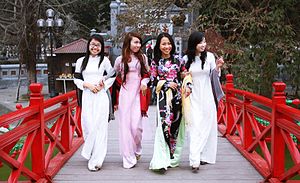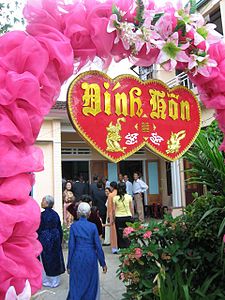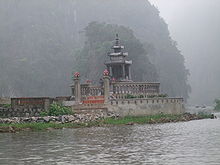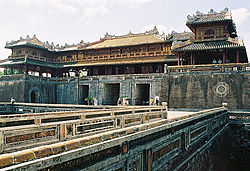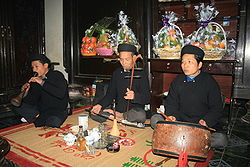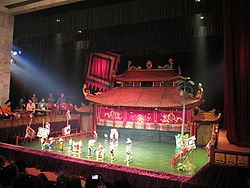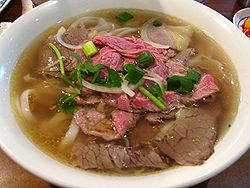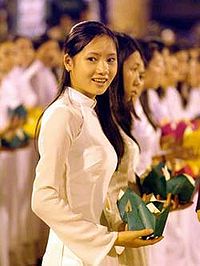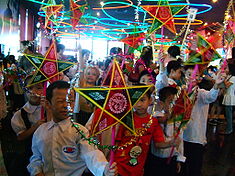- Culture of Vietnam
-
The Culture of Vietnam, an agricultural civilization based on the cultivation of wet rice, is one of the oldest in East Asia; the ancient Bronze age Dong Son culture is considered to be one of its most important progenitors.[1] Due to the long-term Chinese influence on its civilization, in terms of politics, government and Confucian social and moral ethics, Vietnam is considered to be part of the East Asian Cultural Sphere.[2]
Following independence from China in the 10th century, Vietnam began a southward expansion that saw the annexation of territories formerly belonging to the Champa civilization (now Central Vietnam) and parts of the Khmer empire (today southern Vietnam), which resulted in minor regional variances in Vietnam's culture due to exposure to these different groups.
During French colonial period, Vietnamese culture received merchant influences from the Europeans, including the spread of Catholicism and the adoption of Latin alphabet—to this day, Vietnam is the only nation of Indochina which uses the Latin alphabet to write the national language.
In the socialist era, the cultural life of Vietnam has been deeply influenced by government-controlled media and the cultural influences of socialist programs. For many decades, foreign cultural influences were shunned and emphasis placed on appreciating and sharing the culture of communist nations such as the Soviet Union, China, Cuba and others. Since the 1990s, Vietnam has seen a greater re-exposure to Asian, European and American culture and media.
Some elements generally considered to be characteristic of Vietnamese culture include ancestor veneration, respect for community and family values, handicrafts and manual labour, and devotion to study. Important symbols present in Vietnamese culture include dragons, turtles, lotuses and bamboo.
Contents
Society
Organization
In terms of societal levels of organization, the two most important units are làng (village) and nước (country). Vietnamese people usually say that "làng goes hand in hand with nước." Intermediate organizational units are huyện (district) and tỉnh (province).
Kinship
Main article: Vietnamese familyKinship plays an important role in Vietnam. Unlike Western culture's emphasis on individualism, Eastern culture values the roles of family and clanship. Comparing with Eastern cultures, Chinese culture values family over clan while Vietnamese culture values clan over family. Each clan has a patriarch, clan altar, and death commemorations attended by the whole clan.
Most inhabitants are related by blood. That fact is still seen in village names such as Đặng Xá (place for the Đặng clan), Châu Xá, Lê Xá, so on so forth. In the Western highlands the tradition of many families in a clan residing in a longhouse is still popular. In the majority of rural Vietnam today one can still see three or four generations living under one roof.
Because kinship has an important role in society, there is a complex hierarchy of relationships. In Vietnamese society, there are nine distinct generations. Virtually all commemorations and celebrations within a clan follow the principles of these nine generations. Younger persons might have a higher position in the family hierarchy than an older person and still must be respected as an elder. For example, if the parent of a child was older, but had an older cousin whose parent was younger than the first child's parent, then the first child would be higher ranked . In other words, if you are younger than your cousin but your uncle is younger than your father, you would be higher ranked.
This complex system of relationships, a result of both Confucianism and societal norms is conveyed particularly through the extensive use of varying pronouns in Vietnamese language, which has an extensive array of honorifics to signify the status of the speaker in regards to the person they are speaking to.
Marriage
The traditional Vietnamese wedding is one of the most important of traditional Vietnamese occasions. Regardless of Westernization, many of the age-old customs practiced in a traditional Vietnamese wedding continue to be celebrated by both Vietnamese in Vietnam and overseas, often combining both Western and Eastern elements.
In the past, both men and women were expected to be married at young ages. Marriages were generally arranged by the parents and extended family, with the children having limited say in the matter. In modern Vietnam, this has changed as people freely choose their own marriage partners.[3]
Depending on the tradition of specific ethnic groups, marriage includes various steps and related procedures, but generally there are two main ceremonies:[3]
- Lễ Ǎn Hỏi (betrothal ceremony): Some time before the wedding, the groom and his family visit the bride and her family with round lacquered boxes known as betrothal presents. The quantity of boxes must be an odd number. The presents include areca nuts, betel leaves, tea, cake, fruits, wine, other various delicacies and money. The presents are covered with red paper or cloth, and they are carried by unmarried girls or boys. Both families agree to pick a good date for the wedding.
- Lễ Cưới (wedding ceremony): On the wedding day, the groom's family and relatives go to the bride's house to ask permission to for the groom to marry and take his bride to his house. Guests would be invited to come and celebrate the couple's marriage. The couple pray before the altar asking their ancestors for permission for their marriage, then to express their gratitude to both groom's and bride's parents for raising and protecting them.
Funeral Ceremony
Wake
When a person passes away in Vietnam, the surviving family holds a wake or vigil that typically lasts about five to six days, but may last longer if the surviving family is waiting for other traveling relatives. The body is washed and dressed. A le ngam ham, or chopstick, is laid between the teeth and a pinch of rice and three coins are placed in the mouth. The body is put on a grass mat laid on the ground according to the saying, "being born from the earth, one must return back to the earth." The dead body is enveloped with white cloth, le kham niem, and placed in a coffin, le nhap quan. Finally, the funeral ceremony, le thanh phuc, is officially performed.
Funeral
The surviving family wear coarse gauze turbans and tunics for the funeral. There are two types of funeral processions:
- Traditional: The date and time for the funeral procession, le dua tang, must be carefully selected. Relatives, friends, and descendants take part in the funeral procession to accompany the dead along the way to the burial ground. Votives are dropped along the way. At the grave site, the coffin is lowered and buried. After three days of mourning, the family visits the tomb again, le mo cua ma, or worship the opening the grave. After 49 days, le chung that, the family stops bringing rice for the dead to the altar.[clarification needed] And finally, after 100 days, the family celebrates tot khoc, or the end of the tears. After one year is the ceremony of the first anniversary of the relative's death and after two years is the ceremony of the end of mourning.[citation needed]
- Modern: Nowadays, mourning ceremonies follow new rituals which are simplified; they consist of covering and putting the dead body into the coffin, the funeral procession, the burial of the coffin into the grave, and the visits to the tomb.[clarification needed]
Religion and philosophy
Religion in Vietnam has historically been largely defined by the East Asian mix of Buddhism, Confucianism, and Taoism. They are the so-called Tam Giáo, or "triple religion." Beyond Tam Giáo, Catholicism is also practiced in modern Vietnam. Vietnamese Buddhism has typically been the most popular. This fits perfectly with the "triple religion" concept, making it difficult for many Vietnamese to identify exactly which religion they practice.[4]
Besides the "triple religion", Vietnamese life was also profoundly influenced by the practice of ancestor worship, as well as native animism. Most Vietnamese, regardless of religious denomination, practice ancestor worship and have an ancestor altar at their home or business, a testament to the emphasis Vietnamese culture places on filial duty.
Along with obligations to clan and family, education has always played a vital role in Vietnamese culture. In the old days, scholars were placed at the top of society. Men not born of noble blood could only elevate their status by studying for the rigorous Imperial examination. Similar to Mandarin officials, passing the examination could potentially open doors to a government position, granting them power and prestige.
Literature
 "Mysterious tales of the Southern Realm" (Vietnamese: Lĩnh Nam chích quái), dated from Vietnam's Later Le Dynasty.
"Mysterious tales of the Southern Realm" (Vietnamese: Lĩnh Nam chích quái), dated from Vietnam's Later Le Dynasty.
Vietnamese literature includes two major components: folk literature and written literature. The two forms developed simultaneously and are profoundly interrelated.
Vietnamese folk literature came into being very early and had a profound effect on the spiritual life of the Viet. The folk literature contributed to the formation of Vietnam's national identity with praising beauty, humanism, and the love of goodness. Legends, fairy tales, humorous stories, folk songs, epic poems have a tremendous vitality and have lived on until today.
Written literature was born roughly in the 10th century. Up until the 20th century, there had been two components existing at the same time: works written in the Han characters (with poems and prose demonstrating the Vietnamese soul and realities; thus, they were still regarded as Vietnamese literature) and works written in the Nom character (mostly poems; many great works were handed down to the later generations).
Since the 1920s, written literature has been mainly composed in the National language with profound renovations in form and category such as novels, new-style poems, short stories and dramas, and with diversity in artistic tendency. Written literature attained speedy development after the August Revolution, when it was directed by the Vietnamese Communist Party's guideline and focused on the people's fighting and work life.
Modern Vietnamese literature has developed from romanticism to realism, from heroism in wartime to all aspects of life, and soared into ordinary life to discover the genuine values of the Vietnamese people.
Classical literature generated such masterpieces as Truyen Kieu (Nguyễn Du), Cung Oán Ngâm Khúc (Nguyễn Gia Thiều), Chinh Phu Ngam (Dang Tran Con), and Quoc Am Thi Tap (Nguyễn Trãi). Some brilliant female poets are Hồ Xuân Hương, Doan Thi Diem, and Bà Huyện Thanh Quan.
In Vietnamese modern prose, there were authors who could emulate whomever in the world[clarification needed], namely, Nguyen Cong Hoan, Vu Trong Phung, Ngô Tất Tố, Nguyen Hong, Nguyen Tuan and Nam Cao. They were joined by excellent poets: Xuân Diệu, Huy Cận, Han Mac Tu, and Nguyen Binh. Regrettably, their great works that faithfully reflected the country and the times have yet to appear.[clarification needed]
Visual arts
Traditional Vietnamese art is art practiced in Vietnam or by Vietnamese artists, from ancient times (including the elaborate Dong Son drums) to post-Chinese domination art which was strongly influenced by Chinese Buddhist art, among other philosophies such as Taoism and Confucianism. The art of Champa and France also played a smaller role later on.
The Chinese influence on Vietnamese art extends into Vietnamese pottery and ceramics, calligraphy, and traditional architecture. Currently, Vietnamese lacquer paintings have proven to be quite popular.
Calligraphy
Calligraphy has had a long history in Vietnam, previously using Chinese characters along with Chữ Nôm. However, most modern Vietnamese calligraphy instead uses the Roman-character based Quốc Ngữ, which has proven to be very popular.
In the past, with literacy in the old character-based writing systems of Vietnam being restricted to scholars and elites, calligraphy nevertheless still played an important part in Vietnamese life. On special occasions such as the Lunar New Year, people would go to the village teacher or scholar to make them a calligraphy hanging (often poetry, folk sayings or even single words). People who could not read or write also often commissioned at temple shrines.
Performing arts
Music
Vietnamese music varies slightly in the three regions: Bắc or North, Trung or Central, and Nam or South. Northern classical music is Vietnam's oldest and is traditionally more formal. Vietnamese classical music can be traced to the Mongol invasions, when the Vietnamese captured a Chinese opera troupe. Central classical music shows the influences of Champa culture with its melancholic melodies. Southern music exudes a lively laissez-faire attitude.
Vietnam has some 50 national music instruments, in which the set of percussion instruments is the most popular, diverse and long-lasting such as trong dong (copper drums), cong chieng (gongs), dan da (lithophone), dan to rung... The set of blowing instruments is represented by flutes and pan-pipes, while the set of string instruments is specified by dan bau and dan day.
The Vietnamese folksongs are rich in forms and melodies of regions across the country, ranging from ngâm thơ (reciting poems), hát ru (lullaby), hò (chanty) to hát quan họ, trong quan, xoan, dum, ví giặm, ca Huế, bài chòi, ly. Apart from this, there are also other forms like hát xẩm, chầu văn, and ca trù.
Two of the most widely known genres are:
- Imperial Court music: When referring specifically to the "Nhã nhạc" form it includes court music from the Trần Dynasty on to the Nguyễn Dynasty. It is an elaborate form of music which features an extensive array of musicians and dancers, dressed in extravagant costumes. It was an integral part of the rituals of the Imperial court.
- Ca trù: An ancient form of chamber music which originated in the imperial court. It gradually came to be associated with a geisha-type of entertainment where talented female musicians entertained rich and powerful men, often scholars and bureaucrats who most enjoyed the genre. It was condemned in the 20th century by the government, being tied falsely with prostitution, but recently it has seen a revival as appreciation for its cultural significance has grown. Ca trù has been recognized by UNESCO as a Masterpiece of the Oral and Intangible Heritage of Humanity since 2005.
In the 20th century, in contact with the Western culture, especially after the national independence, many new categories of arts like plays, photography, cinemas, and modern art had taken shape and developed strongly, obtaining huge achievements with the contents reflecting the social and revolutionary realities. Up to 1997, there have been 44 people operating in cultural and artistic fields honored with the Ho Chi Minh Award, 130 others conferred with People's Artist Honor, and 1011 people awarded with the Excellent Artist Honor. At the start of 1997, there were 191 professional artistic organizations and 26 film studios (including central and local ones). There have been 28 movies, 49 scientific and documentary films receiving international motion picture awards in many countries.
Theatre
- Hát tuồng (also known as Hát bội): A theatre form strongly influenced by Chinese opera, it transitioned from being entertainment for the royal court to travelling troupes who performed for commoners and peasants, featuring many well-known stock characters.
- Cải lương: A kind of modern folk opera originating in South Vietnam, which utilizes extensive vibrato techniques. It remains very popular in modern Vietnam when compared to other folk styles.
- Hát chèo: Chèo is a form of generally satirical musical theatre, often encompassing dance, traditionally performed by Vietnamese peasants in northern Vietnam. It is usually performed outdoors by semi-amateur touring groups, stereotypically in a village square or the courtyard of a public building, although it is today increasingly also performed indoors and by professional performers
Water puppetry
Water Puppetry is a distinct Vietnamese art which had its origins in the 10th century. In Water Puppetry a split-bamboo screen obscures puppets which stand in water, and are manipulated using long poles hidden beneath the water. Epic story lines are played out with many different puppets, often using traditional scenes of Vietnamese life. The puppets are made from quality wood, such as the South East Asian Jackfruit tree. Each puppet is carefully carved, and then painted with numerous successive layers of paint to protect the puppets.
Despite nearly dying out in the 20th century, Water Puppetry has been recognised by the Vietnamese Government as an important part of Vietnam's cultural heritage. Today, puppetry is commonly performed by professional puppeteers, who typically are taught by their elders in rural areas of Vietnam. It is now extremely popular with tourists, and is performed at the National Museum in Ho Chi Minh city and in specialist theatres. In 2007 a Water Puppet troupe toured the USA to acclaim.
Dancing
Vietnam has 54 different ethnicities, each with their own traditional dance. Among the ethnic Vietnamese majority, there are several traditional dances performed widely at festivals and other special occasions, such as the lion dance.
In the imperial court there also developed throughout the centuries a series of complex court dances which require great skill. Some of the more widely known are the imperial lantern dance, fan dance, and platter dance, among others.
Cuisine
Main article: Cuisine of VietnamVietnamese cuisine is extremely diverse, often divided into three main categories, each pertaining to Vietnam's three main regions (north, central and south). It uses very little oil and many vegetables, and is mainly based on rice, soy sauce, and fish sauce. Its characteristic flavors are sweet (sugar), spicy (serrano peppers), sour (lime), nuoc mam (fish sauce), and flavored by a variety of mint and basil.
Vietnam also has a large variety of noodles and noodle soups. Different regions invented different types of noodles, varying in shapes, tastes, colors, etc. One of the nation's most famous type of noodles is phở (pronounced "fuh"), a type of noodle soup originating in North Vietnam, which consists of rice noodles and beef soup (sometimes chicken soup) with several other ingredients such as bean sprouts and scallions (spring onions). It is often eaten for breakfast, but also makes a satisfying lunch or light dinner. The boiling stock, fragrant with spices and sauces, is poured over the noodles and vegetables, poaching the paper-thin slices of raw beef just before serving. Phở is meant to be savored, incorporating several different flavors: the sweet flavor of beef, sour lemons, salty fish sauce, and fresh vegetables.
Currently, Vietnamese cuisine has been gaining popularity and can be found widely in many other countries such as the United States, Australia, Canada, South Korea, Laos, Japan, China, Malaysia, and France. Vietnamese cuisine is recognized for its strict, sometimes choosy selection of ingredients. A chef preparing authentic Vietnamese cuisine may incorporate the ingredients provided in these countries, but generally will prefer ingredients native to Vietnam.
Clothing
In feudal Vietnam, clothing was one of the most important marks of social status and strict dress codes were enforced.
Commoners had a limited choice of similarly plain and simple clothes for every day use, as well as being limited in the colors they were allowed to use. For a period, commoners were not allowed to wear clothes with dyes other than black, brown or white (with the exception of special occasions such as festivals), but in actuality these rules could change often based upon the whims of the current ruler.
The Áo Tứ Thân or "four-part dress" is one such example of an ancient dress widely worn by commoner women, along with the Áo yếm bodice which accompanied it. Peasants across the country also gradually came to wear silk pajama-like costumes, known as "Áo cánh" in the north and Áo bà ba in the south.
The headgear of peasants often included a plain piece of cloth wrapped around the head (generally called Khăn đống), or the popular Nón Lá (conical hat). For footwear peasants would often go barefoot, whereas sandals and shoes were reserved for the aristocracy and royalty.
Monarchs had the exclusive right to wear the color gold, while nobles wore red or purple. Each member of the royal court had an assortment of different formal gowns they would wear at a particular ceremony, or for a particular occasion. The rules governing the fashion of the royal court could change dynasty by dynasty, thus Costumes of the Vietnamese court were quite diverse.
The most popular and widely-recognized Vietnamese national costume is the Áo Dài. Áo Dài was once worn by both genders but today it is worn mainly by females, except for certain important traditional culture-related occasions where some men do wear it. Áo Dài is derived from the Chinese Qipao, although it consists of a long gown with a slit on both sides, worn over cotton or silk trousers. Áo Dài is elegant and comfortable to wear. Áo Dài was likely derived in the 18th century or in the royal court of Huế.[clarification needed] White Áo dài is the required uniform for girls in many high schools across Vietnam. Some female office workers (e.g. receptionists, secretaries, tour guides) are also required to wear Áo Dài.
In daily life, the traditional Vietnamese styles are now replaced by Western styles. Traditional clothing is worn instead on special occasions, with the exception of the white Áo Dài commonly seen with high school girls in Vietnam.
Martial Arts
Vietnamese martial arts is highly developed from the country's very long history of warfare and attempts to defend itself from foreign occupation. Although most heavily influenced by Chinese martial arts, it has developed its own characteristics throughout the millennia in combination with other influences from its neighbours. Vietnamese martial arts is deeply spiritual due to the influence of Confucianism, Buddhism and Taoism, and is strongly reliant on the "Viet Vo Dao" (philosophy of Vietnamese martial arts). It is probably most famous for its scissor kicks.
The general Vietnamese term for martial arts is "Võ-Thuật." Some of the more popular include:
- Vovinam
- Võ Bình Định
- Quan Khi Dao
Vietnamese martial arts remains relatively unknown in the world today when compared to its counterparts from China, Japan, Korea or Thailand. However, this is seeing a definite change as schools teaching various styles of Vietnamese martial arts are starting to pop up all over the world, notably in countries such as Spain.[citation needed]
Holidays and other important days
Vietnam celebrates many holidays, including traditional holidays which have been celebrated in Vietnam for thousands of years, along with modern holidays imported predominantly from western countries.
Among the traditional holidays, the two most important and widely celebrated are the Lunar new year (Tết), followed by the Mid-autumn lantern festival (Tết Trung Thu), although the latter has been losing ground in recent years.
Public holidays
Date English Name Local Name Remarks January 1 New Year's Tết dương lịch New Year's Day. Between late January–late February Tết (Lunar New Year) Tết Nguyên Đán Largest holiday of the year, falling on the first three days of lunar calendar; in practice, celebrations are held during the weeks before and after those three days. April 30 Liberation Day Ngày miền Nam hoàn toàn giải phóng, và ngày thống nhất Việt Nam. The day Saigon was liberated, leading to the South Vietnam government's dissolvement and Vietnam's unification. May 1 Labour Day Ngày Quốc tế Lao động Celebrates the economic and social achievements of workers. September 2 National Day Quốc khánh Commemorates Ho Chi Minh's speech in Ba Dinh Square in 1945, declaring Vietnam's independence 10/3 (lunar) Hung Vuong Kings Commemoration Day Ngày Giổ Tổ Hùng Vương Other holidays
Date English Name Local Name March 8 International Women's Day Quốc tế Phụ nữ November 20 Teacher's Day Ngày Nhà giáo Việt Nam December 25 Christmas Giáng sinh/Nôen October 20 Vietnam Women's Day Ngày Phụ nữ Việt Nam June 1 Children's day Tết thiếu nhi 15/1 (lunar) Full moon of the 1st month Rằm tháng giêng 3/3 (lunar) Third lunar month's third day's festival Tết Hàn thực 15/4 (lunar) Buddha's Birthday Lễ Phật Đản 5/5 (lunar) Midyear Festival Tết Đoan ngọ 15/7 (lunar) Full moon of the 7th month or Piety Day Rằm tháng bảy hoặc Lễ Vu Lan 15/8 (lunar) Mid-Autumn Festival Tết Trung thu 23/12 (lunar) Kitchen guardians Ông Táo chầu trời World and Intangible Cultural Heritage
Vietnam has a number of UNESCO-listed World Heritage Sites, as well as cultural relics deemed as Intangible heritage. These are split into specific categories:
Cultural heritage sites
- Hội An: An ancient city and trading center.
- Imperial city of Huế: Complex of monuments in the former imperial capital.
- Mỹ Sơn: Ancient temple complex of the former Champa civilization in Quang Nam province.
Natural heritage sites
- Phong Nha cave located in Quang Binh province.
- Ha Long Bay
Intangible cultural heritage
- Nhã nhạc: A form of Vietnamese court music.
- Space of Gong culture in the Central Highlands of Vietnam
- Ca trù
- Quan họ
There are a number of other potential world heritage sites, as well as intangible cultural heritages which Vietnam has completed documents on for UNESCO's recognition in the future.
See also
- History of Vietnam
- Cinema of Vietnam
- Communications in Vietnam
- Media of Vietnam
- Politics of Vietnam
- Vietnamese name
- Vietnamese language
- Baiyue
- Vietnamese studies
References
- ^ Embassy of Vietnam in the United States of America. "Evolution of culture". http://www.vietnamembassy-usa.org/learn_about_vietnam/culture/evolution/. Retrieved 2010-05-16.
- ^ Columbia University East Asian Cultural Sphere
- ^ a b Peter C. Phan (2005). Vietnamese-American Catholics. Ethnic American pastoral spirituality series. Paulist Press. ISBN 0809143526.
- ^ Vietnam Culture - Ruba
- Releasing the 2009 Population & Housing Census Preliminary Results. People's Committee of Ho Chi Minh City.
- Vietnamese culture and society. Embassy of Vietnam in the USA.
External links
- Vietnamese culture and society. Embassy of Vietnam in the USA.
- Vietnamese Culture and History. Vietspring.org.
- Vietnam Cultural Profile
- Vietnamese Culture and Traditions
- Vietnamese Poetry
- Vietnamese Culture and Traditions
- Vietnamese culture index - Vietnam Online
 Vietnam topics
Vietnam topicsHistory Politics Government ExecutiveLegislativeEconomy Agriculture · Doi Moi · Five-Year Plans · International rankings · Manufacturing · Tourism · Vietnamese dong (VND)Transport Geography Society Arts Other topics Communications · National flag / coat of arms · Provinces · Diaspora · Human rights (LGBT rights) · Vietnamese studiesCulture of Asia Sovereign
states- Afghanistan
- Armenia
- Azerbaijan
- Bahrain
- Bangladesh
- Bhutan
- Brunei
- Burma (Myanmar)
- Cambodia
- People's Republic of China
- Cyprus
- East Timor (Timor-Leste)
- Egypt
- Georgia
- India
- Indonesia
- Iran
- Iraq
- Israel
- Japan
- Jordan
- Kazakhstan
- North Korea
- South Korea
- Kuwait
- Kyrgyzstan
- Laos
- Lebanon
- Malaysia
- Maldives
- Mongolia
- Nepal
- Oman
- Pakistan
- Philippines
- Qatar
- Russia
- Saudi Arabia
- Singapore
- Sri Lanka
- Syria
- Tajikistan
- Thailand
- Turkey
- Turkmenistan
- United Arab Emirates
- Uzbekistan
- Vietnam
- Yemen
States with limited
recognition- Abkhazia
- Nagorno-Karabakh
- Northern Cyprus
- Palestine
- Republic of China (Taiwan)
- South Ossetia
Dependencies and
other territoriesCategories:- Vietnamese culture
Wikimedia Foundation. 2010.


